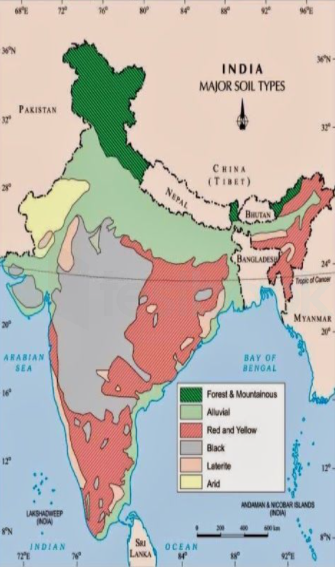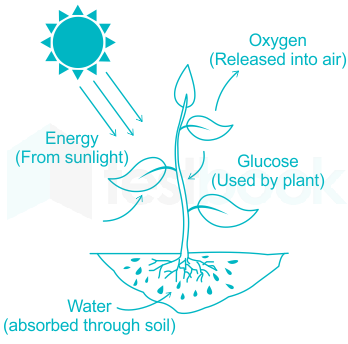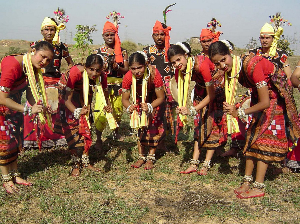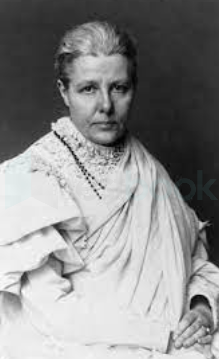- Pre-monsoon shower
- Monsoon rainfall
- Mango shower
- Local wind
The correct answer is a Pre-monsoon shower.
 Key Points
Key Points
Pre-monsoon shower:
- These rains normally occur from March to April, although their arrival is often difficult to predict.
- Their intensity can range from light showers to heavy and persistent thunderstorms.
- In India, mango showers occur as the result of thunderstorm development over the Bay of Bengal.
- They are also known as ‘Kaal Baisakhi’ in Bengal, as Bordoisila in Assam, and as Cherry Blossom showers or Coffee Showers in Kerala.
 Additional Information
Additional Information
| LIST OF LOCAL WINDS | ||
| LOCAL WINDS | DESCRIPTION | FOUND AT |
| Blossom Shower |
|
|
| Mango Shower |
|
|
| Loo |
|
|
Nor Westers |
|
|
- 34
- 15
- 17
- 12
The correct answer is 12.
- Ellora Caves houses 12 Buddhist caves in it.
 Key Points
Key Points
- Ellora caves:
- They are located a hundred kilometres from Ajanta in the Aurangabad district.
- It has a total of thirty-four Buddhist, Brahmanical and Jain caves.
- 12 Buddhist caves
- 17 Hindu Caves
- 5 Jain Caves
- This set of caves was developed during the period between the 5th and 11th centuries A.D.
- Ellora is a unique art-historical site in the country as it has monasteries associated with the three religions– Buddhism, Brahmanism and Jainism.
- The images of Padmapani and Vajrapani are found in both Ajanta and Ellora caves.
- In the Ellora Caves, Buddha images are generally guarded by the images of Padmapani and Vajrapani.
- Some of the prominent caves in Ellora are:
- Cave No. 10- Buddhist Chaitya cave is known as Vishwakarma Cave or carpenter’s cave. Buddha is seated in Vyakhyana Mudra here and the Bodhi tree is carved at his back.
- Cave No. 14 is themed “Raavan ki Khai”.
- Cave No. 15 is the Dashavatar temple.
- Cave No. 16 is the Kailash temple dedicated to Lord Shiva. It was developed under the patronage of Rashtrakuta king Krishna I and was carved out of a monolith, and even has a courtyard. There is also a sculpture on the wall of the Kailash temple depicting Ravana shaking Mount Kailasha. It is considered one of the masterpieces of Indian sculpture.
- Cave No. 29- Dhumar Lena.
- Cave No. 21- Rameshwar temple
- Two famous Jain caves are Indra Sabha (Cave 32) and Jagannath Sabha (Cave 33).

- Lateritic soil
- Red soil
- Black soil
- Alluvial soil
The correct answer is Alluvial soil.
 Important Points
Important Points
- Alluvial soil is mostly available soil in India that covers about 43 per cent of the total area of the country.
- It is widespread in northern plains and river valleys.
- In peninsular India, they are mostly found in deltas and estuaries.
- Humus, lime, and organic matters are present in this soil and highly fertile.
- It is found in Indus-Ganga-Brahmaputra plain, Narmada-Tapi plain, etc are examples.
- They are depositional soil – transported and deposited by rivers, streams, etc.
- New alluvium is termed as Khadar and old alluvium is termed as Bhangar.
- Its color is Light Grey to Ash Grey.
- Its texture is Sandy to silty loam or clay.
- Wheat, rice, maize, sugarcane, pulses, oilseed, etc are cultivated mainly in this soil.
 Additional Information
Additional Information
- Different types of Indian soil:
- Alluvial soil [43%]
- Red soil [18.5%]
- Black / regur soil [15%]
- Arid/desert soil
- Laterite soil
- Saline soil
- Peaty/marshy soil
- Forest soil
- Sub-mountain soil
- Snowfields

- Mumbai
- Goa
- Delhi
- Calcutta
The correct answer is Goa.
 Key Points
Key Points
- The first printing press in India was introduced in Goa.
- The first printing press in India was set up in 1556 at St. Paul’s College, Goa.
- Father Gasper Caleza spoke of a ship carrying a printing press to sail from Portugal to Abyssinia (current-day Ethiopia) to promote missionary work in Abyssinia.
- Due to some circumstances, this printing press was prohibited from leaving India.
- As a result, printing operations began in Goa in 1556.
- A professional printer was sent to follow the printing press and, along with his Indian assistant, set up and began to run it.
- The first book was published by Portuguese missionaries in 1557.
 Additional Information
Additional Information
- Bhimbi Parikh, an Indian businessman established Bombay’s first printing press around 1674-75.
- Two printing presses were simultaneously set up in Calcutta in 1777 by James Augustus Hickey and Nathaniel Brassley Halhed.
- Temperate Zone
- Frigid Zone
- Torrid Zone
- None of these
Explanation:
Torrid zone refers to the hottest central belt of the earth bounded by the Tropic of Cancer and Tropic of Capricorn, characterized by a hot climate. It lies between 23 ½° North latitude and 23 ½° South latitude. It is also known as the hottest zone as it is very close to the equator and sun rays fall directly on it.
- The zone between the Tropic of Cancer and Tropic of Capricorn is known as the torrid zone.
- There are mainly 3 heat zones on the Earth’s surface that arise due to temperature differences. They are –
Zones | Location |
Frigid Zone | Further divided into 2 zones:
|
Temperate Zone | Further divide into 2 zones:
|
Torrid zone |
|
- Alauddin Khalji
- Jalaluddin Khalji
- Mohammad Bin Tughlaq
- Feroz Shah Tughlaq
The correct answer is Mohammad Bin Tughlaq.
 Key Points
Key Points
- Ibn Battuta visited India during the rule of Mohammed Bin Tughlaq.
- Ibn Battuta was a Moroccan traveller.
- Rihla was a book written by Ibn Batuta.
- Rihla is a travelogue based upon the experiences of the travellers.
 Additional Information
Additional Information
| Traveller | Period | Nationality | Rulers | work |
Deimachos | 320-273 BC | Greek | Bindusara | |
Megasthenes | 302-298 B.C. | Greek | Chandragupta Maurya. | Indica. |
Ptolemy | 130 A.D. | Greek | Geography of India | |
Fa-Hien | 405-411 A.D. | Chinese | Chandragupta II Vikramaditya | Fo-Kyo-Ki |
Hiuen-Tsang | 630-645 A.D. | Chinese | Harshavardhana | Si-Yu-Ki |
Al- Beruni | 1024-1030 A.D. | Afghan | Mahmud Ghazni, Chandela Dynasty | Kitab-ul-Hind |
Marco Polo | 1292-1294 AD | Venetian | Pandya Dynasty | The Book of Sir Marco Polo |
| Ibn Batuta | 1333-1347 A.D. | Morrocco | Muhammad-Bin-Tughlaq | Rehla/Rihla |
- phloem
- xylem
- chlorophyll
- tissue
The correct answer is chlorophyll.
Explanation:
- Chlorophyll is a pigment present in the chloroplast which gives green colour to plants.
- Chlorophyll is a leaf that is required for trapping light energy.
- The energy trapped by chlorophyll is used to synthesize food from carbon dioxide and water.
- It exists in several forms but chlorophyll a and chlorophyll b are the most common.
- Chlorophyll a is the chief pigment associated with photosynthesis.
- It is found in all photosynthetic organisms such as cyanobacteria.
- Plants cannot synthesize their food without the help of chlorophyll.
- Solar energy is stored in the form of food in the leaves with the help of chlorophyll.
 Important Points
Important Points
- Photosynthesis is the process by which plants use sunlight, water, and carbon dioxide to create oxygen and energy in the form of sugar.
- During photosynthesis, plants take in carbon dioxide (CO2) and water (H2O) from the air and soil.
- Within the plant cell, the water is oxidized, meaning it loses electrons, while the carbon dioxide is reduced, meaning it gains electrons. This transforms the water into oxygen and the carbon dioxide into glucose.

 Additional Information
Additional Information
- Phloem is tissue in plants that conduct food to other parts of the plant.
- Phloem is also called bast.
- The xylem is a vascular tissue which conveys water and dissolved minerals to the rest of the plant.
- It also provides physical support.
- The Brahmagiri hills
- The Trimbak hills
- The Amarkantak plateau
- Mahabaleshwar
The correct answer is The Brahmagiri hills.
 Key Points
Key Points
- The Brahmagiri hills
- It is located in the Western Ghats of Karnataka state.
- It is in between Kodagu district, Karnataka, and Wayanad district, Kerala state.
- Kaveri river
- The river is joined by two tributaries known as the Hemavati and Lakshmantirtha.
- It is known as the sacred river of southern India.
- The Kaveri river rises on Brahmagiri Hill of the Western Ghats.
- It flows through the states of Karnataka and Tamil Nadu.
 Additional Information
Additional Information
- The Trimbak hills
- It is a mountain range in the Western Ghats of Maharashtra.
- The northern face of the range is the birthplace of Godavari.
- Godavari river is India’s second-longest river.
- The place is also famous for the Trimbakeshwar Shiva temple.
- The Amarkantak plateau
- It is a mountain range located in the Anuppur district, Madhya Pradesh.
- It forms the eastern base of the triangular-shaped Satpura Range.
- The Satpura-Maikala watershed is known as the second-largest in India.
- It is a place where the rivers Narmada, Son and Johila emerge.
- Mahabaleshwar
- It is a small town in Satara district, Maharashtra.
- It was served as the summer capital of the Bombay Presidency in the British period.
- It is situated in the Sahyadri range of the Western ghats.
- This region is the source of the Krishna River.
- The river flows across the states of Maharashtra, Karnataka, Telangana and Andhra Pradesh.
- Ganesh Chaturthi
- Holi
- Dussehra
- Diwali
The correct answer is Ganesh Chaturthi.
 Key Points
Key Points
- Nuakhai is an agricultural festival celebrated by the people of Odisha.
- It is the greatest harvesting festival of Odisha.
- It is observed to welcome the new rice of the season.
- Nua means new and Khai means food i.e. Nuakhai’s Hindi meaning is ‘new food’.
- ‘Nuakhai’ festival is celebrated one day after the Ganesh Chaturthi festival.
- The festival has a big significance for farmers and the agricultural community.
- The festival is observed on Panchami tithi (the fifth day) of the lunar fortnight of the month of Bhadrapada (August–September) as per the Hindu calendar
- ‘Nuakhai’ is the most important social festival of Western Odisha.
- It is also celebrated in Southern Chhattisgarh.

 Important Points
Important Points
- Ganesh Chaturthi is a 10-day long festival marking the birth of the elephant-headed deity Ganesha.
- It is also called Vinayaka Chaturthi.
- The festival begins on the fourth day (Chaturthi) of the month of Bhadrapada(the sixth month of the Hindu calendar).
- Idols of Ganesha are placed on raised platforms in homes or in elaborately decorated outdoor tents as a part of this festival.
 Additional Information
Additional Information
- Holi is a festival of Colors in India celebrating the victory of good over evil, the destruction of the demoness Holika.
- Dussehra is a festival that celebrates Lord Rama’s victory over asura king Ravana as well as the triumph of Goddess Durga over Mahishasur.
- Diwali is the festival that celebrated India to mark the return of Hindu god Lord Rama to Ayodhya in northern India after he defeated Ravana.
- Developing the private sector on an observation-oriented model
- Developing Public-Private Partnerships Based on Keynesian Economics
- Developing the Tertiary Sector on the Harrod-Domar Model
- Developing a Priority Sector on the Harrod-Domar Model
The correct answer is Developing a Priority Sector on the Harrod-Domar Model. Key Points
Key Points
- First Five-Year Plan :-
- The First Five-Year Plan in India was from 1951 to 1956.
- The plan was based on the Harrod-Domar model.
- The main focus of this plan was to develop a Priority Sector.
- Gave priority to the agricultural development of the country.
- The First Five Year Plan was presented before the parliament by Jawaharlal Nehru.
- Economist K N Raj is known as the architect of this plan.
- It was quasi successful for the government.
 Additional Information
Additional Information- Second Five-Year Plan:-
- From 1956 to 1961.
- Based on the Mahalanobis model.
- Gave priority to the Industrial development of the country.
- Durgapur (West Bengal), Bhilai (Chhattisgarh), Raurkela(Odisha) steel plants of India started during this plan.
- Fourth Five Year Plan :-
- From 1969 to 1974.
- The two main objectives of this plan were growth with stability and progressive achievement of self-reliance.
- Indo-Pak war of 1971 was during this five-year plan.
- Operation flood was launched during this plan.
- Fifth Five Year Plan :-
- From 1974 to1979.
- Priority was given to agriculture, industry, and mines.
- The draft of this plan was prepared and launched by the D.P. Dhar.
- 20 Point Program Launched During this plan.
- Sixth Five Year Plan:-
- From 1980 to 1985.
- Aim: Poverty eradication and technological self-reliance.
- NABARD was established in 1982.
- Eighth Five Year Plan:-
- From 1992 to 1997.
- Priority was given to the development of human resources (Human Model).
- Beginning of liberalization, privatization, and globalization (LPG) in India.
- New Economic policy introduced.
- Article 22
- Article 20
- Article 21
- Article 19
The correct answer is Article 19.
- Access to the internet is the fundamental right under Article 19.
 Key Points
Key Points
- Fundamental Rights:
- The Fundamental Rights are described in Articles 12-35, Part III of the Indian Constitution.
- The Right to Property (Article 31) was deleted from the list of Fundamental Act, 1978.
- By the 44th Amendment Act, 1978, it is made a normal constitutional right under Act 300A in Part XII of the Constitution.
- Article 19:
- It guarantees six rights to all citizens:
- Right to freedom of speech and expression (ii) Right to assemble peacefully and without arms.
- Right to form associations or unions or co-operative societies.
- Right to move freely throughout the territory of India.
- Right to reside and settle in any part of the territory of India.
- Right to practice any profession or to carry on any occupation, trade, or business.
- The right to the Internet was made a fundamental right under Article 19(1)(a) of the Constitution.
- It was made a fundamental right in the year 2020.
- It guarantees six rights to all citizens:
 Additional Information
Additional Information
- Article 20: Protection in respect of conviction for offences.
- Article 21: No person shall be deprived of his life or personal liberty except according to the procedure established by law.
- Article 22: No person who is arrested shall be detained in custody without being informed of the ground for such arrest.
 Important Points
Important Points
- Fundamental rights are called the Cornerstone of the Constitution.
- Fundamental rights + DPSP are called Conscience of the Constitution.
- sericulture
- pisciculture
- apiculture
- aquaculture
The correct answer is Apiculture.
Explanation:
| Culture | Description |
| Sericulture |
|
| Pisciculture |
|
| Apiculture |
|
| Aquaculture |
|
Concept:
- Apiculture is also known as beekeeping where honey bees are reared in order to produce honey and wax.
- Hence the correct answer for this question is – Apiculture.
 Important Points
Important Points
Aquaculture v/s Pisciculture:
- Aquaculture is the method of raising, rearing, and harvesting commercially valuable aquatic flora and fauna in salt or freshwater, while pisciculture is the process of culturing fish (fish farming) to obtain fish and fish products for human consumption.
- Aquaculture involves the overall cultivation of different aquatic forms and not only fishes whereas pisciculture’s basic aim is to cultivate only fishes.
- Rowlatt
- Civil Disobedience
- Non co-operation
- Quit India
he correct answer is Civil Disobedience.
 Key Points
Key Points
- The Gandhi-Irwin Pact was associated with the civil disobedience movement of India.
- The agreement was signed by Mahatma Gandhi and Lord Irwin.
- The pact was signed on 5th March 1931.
- Arranged before the second round table conference in London.
- As per Gandhi-Irwin Pact, Gandhiji discontinued the Civil Disobedience movement and agreed to attend the second round table conference.
- Proposed conditions of the Gandhi-Irwin Pact are:
- Participation by the Indian National Congress in the Second Round Table Conference.
- Removal of the tax on salt.
- Withdrawal of all ordinances imposing curbs on the activities of the Indian National Congress issued by the Government of India.
- Discontinuation of Salt March.
- The non-Co-operation movement was the first mass political movement led by Gandhiji.
- Started in 1920.
- Main goal: The attainment of Swaraj.
- Rowlatt Act was passed on 6th February 1919.
- Gandhiji called this act as ‘The Black Act’.
- Lord Chelmsford was the British viceroy during the Rowlatt Act.
- Quit India resolution was passed on 8th August 1942.
- The failure of the Crips mission was the immediate cause of the Quit India movement.
- “Quit India” was the famous slogan raised during this movement.
- Jia Pingwa
- Arundhati Roy
- Sunita Narain
- Dan Brown
The correct answer is Arundhati Roy Key Points
Key Points
- Arundhati Roy is a Political Activist and Writer.
- Her debut Novel is the “God of Small Things” has won the Booker Prize in 1997.
- The Novel depicts Corruption, Political Violence, and Capitalism.
 Additional Information:Sunita Narian has written the book ‘Conflicts of Interest; My journey through India’s Green Movement” in 2017.
Additional Information:Sunita Narian has written the book ‘Conflicts of Interest; My journey through India’s Green Movement” in 2017.
- India’s foremost environmentalist, Sunita Narain gives a personal account of her battles as part of the country’s Green Movement.
- While outlining the enormous environmental challenges that India faces today.
- Narain talks about how corporate lobbies and political interests often scuttle their effective resolution.
- Sunita Narain is an Indian environmentalist and political activist as well as a major proponent of the Green concept of sustainable development.
- Movies: – Before the Flood, River blue, Flow: For Love of Water, Weather Report
- Awards: – Stockholm Water Prize, Padma Shri
- Books: – Excreta Matters, Capitan America: US Climate Goals: a Reckoning, Not in My Backyard: Solid Waste Management in Indian Cities.
| Book | Author |
| Da Vinci Code | Dan Brown |
| The LowLand | Jhumpa Lahiri |
| When God is a Traveller | Arundhati Subramaniam |
| Speed Post | Shobhaa De |
| Beyond Religious Ethics for a Whole World | Dalai Lama |
| Kashmir: The Unwritten History | Christopher Snedden |
| India: The Future is Now | Shashi Tharoor |
| Half Lion: How Pv Narsimha Rao transformed India | Vinay Satpati |
| Lone Fox Dancing | Ruskin Bond |
| Quichotte | Salman Rushdie |
- Carbon dioxide
- Oxygen
- Hydrogen
- Nitrogen
The correct answer is Hydrogen.
The metal reacts with acids to form salt and hydrogen gas.
Metals that are above in the reactivity series react with acid.
| Metal | Symbol | |
These metals are more reactive than hydrogen | Potassium Sodium Calcium Magnesium Aluminum Zinc Iron Tin lead | K Na Ca Mg Al Zn Fe Sn Pb |
Hydrogen | H | |
These metals are less reactive than hydrogen | Copper Mercury Silver Gold | Cu Hg Ag Au |
- Bronze Age
- Stone Age
- Gold Age
- None of the above
- The Bronze Age is characterized by the use of tools made from bronze, an alloy of copper and tin.
- The Indus Valley Civilisation was a Bronze Age civilization that existed in the northwestern part of South Asia from 2500–1700 BCE.
- The civilization is known for its development of techniques in metallurgy and the use of bronze, copper, lead and tin for utensils, sculptures, vessels, and jewellery.
 Additional Information
Additional Information
- The Indus Valley Civilization was spread from present-day North-East Afghanistan to Pakistan and North-West India. This civilization flourished in the river basins of the Ghaggar-Hakra river and the Indus. Indus valley civilization is one of the four oldest civilizations in the world. It is also known as Harappan Civilization and is well-known for its organized planning based on the grid system. Important facts to be remembered
- John Marshall was the first researcher to use the term, ‘Indus Valley Civilization’.
- Indus Valley Civilization spread from the year 2500 – 1750 BC according to radio-carbon dating.
- The most distinctive feature of the Harappan Civilization was its urbanization.
- Moreover, sheep and goats, dogs, humped cattle buffalo, and elephants were domesticated in the Indus Valley Civilization.
- The capital cities are Mohenjodaro and Harappa.
- The port cities are Sutkagendor, Balakot, Lothal, Allahdino, and Kuntasi.
- The Indus valley people were well-acquainted with the use of both cotton and wool.
- Name of the major cities are given below:
- Mohenjodaro (Sind)-It is located on the right bank of the Indus.
- Kalibangan (Rajasthan)-It was on the banks of the river Ghaggar river
- Chanhudaro-It lies on the left bank of the Indus in the south of Mohenjodaro.
- Lothal- It is located at the head of the Gulf of Cambay.
- Surkotada (Gujarat)-It is at the head of the Rann of Kutch.
- Banawali (Haryana)-It was situated on the banks of the now-extinct Sarasvati
- Dholavira (Gujarat)-It excavated is in the Kutch district
- Annie Besant
- Sonia Gandhi
- Indira Gandhi
- Sarojini Naidu
The correct answer is Annie Besant.
 Key Points
Key Points
- Annie Besant was the first woman president of the Indian National Congress.
- She presided the INC at the Calcutta session of 1917
- She was of Irish origin and was one of the few foreigners who played a significant role in the Indian freedom movement.
- She was a sociologist, theosophist, social reformer, and advocate of Indian self-rule.
- Besant first visited India in 1893 and later settled there, becoming involved in the Indian nationalist movement.
- In 1916 she established the Indian Home Rule League, of which she became president.

 Additional Information
Additional Information
- A total of 61 people have served as the president of the Indian National Congress since its formation.
- Sonia Gandhi is the longest-serving president of the party, having held office for over twenty years from 1998 to 2017 and since 2019.
- The President of the Indian National Congress is the highest command of the Indian National Congress (INC), a political party in India.
 Confusion Points
Confusion Points
Sarojini Naidu was elected as the President of the Indian National Congress Party in 1925, the first-ever Indian woman to assume that position.
- Chhau
- Mohiniyattam
- Sattriya
- Kuchipudi
The correct answer is Sattriya.
- Sattriya is a famous dance form of Assam located in North East India which means the body of dance.
 Key Points
Key Points
- The Sattriya dance was evolved in the later 15th century.
- The dance was propagated by the saint and reformer of Assam, Sankaradeva and it became a medium for the propagation of the Vaishnava faith.
- This Sattriya has two separate streams:
- The Bhaona- which is related repertoire starting from the Gayan-Bhayanar Nach to the Kharmanar Nach,
- Secondly, the dance numbers which are independent, such as Chali, Rajagharia Chali, Jhumura, Nadu Bhangi etc.
 Additional Information
Additional Information
- Chhau dance is a traditional dance form of eastern India, it enacts episodes from epics like Mahabharata and Ramayana, local folklore and abstract themes.
- Mohiniyattam is a classical dance form of Kerala.
- Mohiniyattam gets its name from the word ‘Mohini’, which is the feminine form of Lord Vishnu; the word means ‘dance of Mohini’.
- Kuchipudi is a classical dance form of Andhra Pradesh.
- Bhag
- Bali
- Udaka
- Shulk
Shulk was not a land related tax during Mauryan period.
 Key Points
Key Points
- Land revenues from the rural areas during the Mauryan period were appropriated in the form of crown lands (sita), land revenue (bhaga) from cultivators, taxes on orchards, ferry charges and so on.
- Different types of taxes that were imposed on rural population during the Mauryan period are:
- Bhaga – It was levied at the rate of one-fourth to one-sixth. Sharecroppers and other agricultural support by the state had to pay half of the produce to the state.
- Pindikara – It was a tax levied on groups of villages and paid by farmers. This was customary. Often the villages were supposed to supply provisions to the royal army when they pass through their respective territories.
- Hiranya – It was a tax paid in cash.
- Bali – This was popular in the Vedic times and continued under the Mauryas.
- Pranaya – This literally means a gift of affection. It was levied imposed by the state during emergency. Pranaya amounted to one-third or one-fourth of the produce according to the nature of the soil.
- Udaka – When the importance of irrigation was fully realised, the peasants had to pay more tax on irrigated land which was known as udaka-bhaga. It refers to water rate, and was generally levied at one-fifth to one-third of the produce.
 Mistake Points
Mistake PointsShulk was an urban tax collected during the Mauryan period.
Based on the above discussion, we can conclude that Shulk was not a land related tax during Mauryan period.
- Chola
- Kushan
- Mauryan
- Gupta
The correct answer is Mauryan.
 Key Points
Key Points
- The Mauryan empire, in ancient India, was a state centered at Pataliputra (later Patna).
- It lasted from about 321 to 185 BCE and was the first empire to encompass most of the Indian subcontinent.
- The Mauryan empire was founded by Chandragupta Maurya.
- The Mauryan Empire was the first pan-Indian empire, It covered most of the Indian region.
 Additional Information
Additional Information
- Kerala, Tamil Nadu, and parts of the Northeast were the only parts that were not under Mauryan rule.
- Kautilya was the Prime Minister of the Chandra Gupta, and Bindusara.
- Ashoka the greatest ruler of the Mauryan Empire was the son of Bindusara.
- Dhamma is introduced by Ashoka.
- The Mauryan army was the largest military force of its time.
- Maurya Empire reached its greatest territorial extent under Ashoka the Great.
- One of the most important features of Mauryan art is the bright polish imparted to the stone surface which makes it shine and look impressive.
- Important kings of the Mauryan empire, Chandra Gupta Maurya, Bindusara, and Ashoka.
 Important Points
Important Points
- Chola Dynasty -The Chola Empire was founded by Vijayalaya(848–871).
- Khusans Dynasty–Kujula Kadphises [AD 30-AD 80) was a founder of the Khusans Dynasty.
- Gupta Dynasty– The Gupta dynasty was established by Shrigupta.
- The real founder of the Gupta empire was Chandragupta I (AD 319–334).
Download Our App for Quiz .
Quiz available at GENERAL STUDIES_ MINI MOCK- Level 1 & 2

